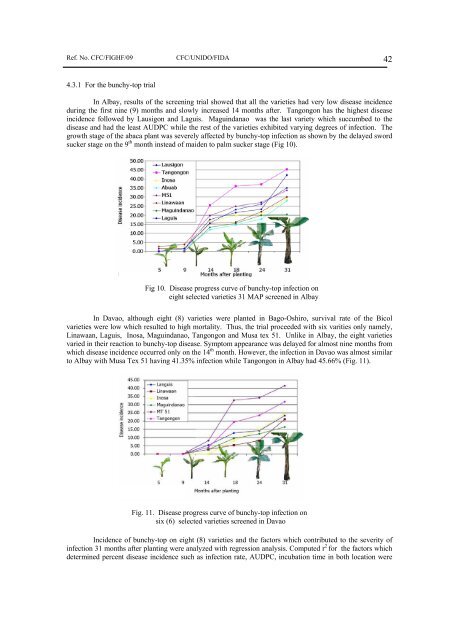ABACA Activities in the Philippines - Unido
ABACA Activities in the Philippines - Unido
ABACA Activities in the Philippines - Unido
Create successful ePaper yourself
Turn your PDF publications into a flip-book with our unique Google optimized e-Paper software.
Ref. No. CFC/FIGHF/09 CFC/UNIDO/FIDA 42<br />
4.3.1 For <strong>the</strong> bunchy-top trial<br />
In Albay, results of <strong>the</strong> screen<strong>in</strong>g trial showed that all <strong>the</strong> varieties had very low disease <strong>in</strong>cidence<br />
dur<strong>in</strong>g <strong>the</strong> first n<strong>in</strong>e (9) months and slowly <strong>in</strong>creased 14 months after. Tangongon has <strong>the</strong> highest disease<br />
<strong>in</strong>cidence followed by Lausigon and Laguis. Magu<strong>in</strong>danao was <strong>the</strong> last variety which succumbed to <strong>the</strong><br />
disease and had <strong>the</strong> least AUDPC while <strong>the</strong> rest of <strong>the</strong> varieties exhibited vary<strong>in</strong>g degrees of <strong>in</strong>fection. The<br />
growth stage of <strong>the</strong> abaca plant was severely affected by bunchy-top <strong>in</strong>fection as shown by <strong>the</strong> delayed sword<br />
sucker stage on <strong>the</strong> 9 th month <strong>in</strong>stead of maiden to palm sucker stage (Fig 10).<br />
Fig 10. Disease progress curve of bunchy-top <strong>in</strong>fection on<br />
eight selected varieties 31 MAP screened <strong>in</strong> Albay<br />
In Davao, although eight (8) varieties were planted <strong>in</strong> Bago-Oshiro, survival rate of <strong>the</strong> Bicol<br />
varieties were low which resulted to high mortality. Thus, <strong>the</strong> trial proceeded with six varities only namely,<br />
L<strong>in</strong>awaan, Laguis, Inosa, Magu<strong>in</strong>danao, Tangongon and Musa tex 51. Unlike <strong>in</strong> Albay, <strong>the</strong> eight varieties<br />
varied <strong>in</strong> <strong>the</strong>ir reaction to bunchy-top disease. Symptom appearance was delayed for almost n<strong>in</strong>e months from<br />
which disease <strong>in</strong>cidence occurred only on <strong>the</strong> 14 th month. However, <strong>the</strong> <strong>in</strong>fection <strong>in</strong> Davao was almost similar<br />
to Albay with Musa Tex 51 hav<strong>in</strong>g 41.35% <strong>in</strong>fection while Tangongon <strong>in</strong> Albay had 45.66% (Fig. 11).<br />
Fig. 11. Disease progress curve of bunchy-top <strong>in</strong>fection on<br />
six (6) selected varieties screened <strong>in</strong> Davao<br />
Incidence of bunchy-top on eight (8) varieties and <strong>the</strong> factors which contributed to <strong>the</strong> severity of<br />
<strong>in</strong>fection 31 months after plant<strong>in</strong>g were analyzed with regression analysis. Computed r 2 for <strong>the</strong> factors which<br />
determ<strong>in</strong>ed percent disease <strong>in</strong>cidence such as <strong>in</strong>fection rate, AUDPC, <strong>in</strong>cubation time <strong>in</strong> both location were

















